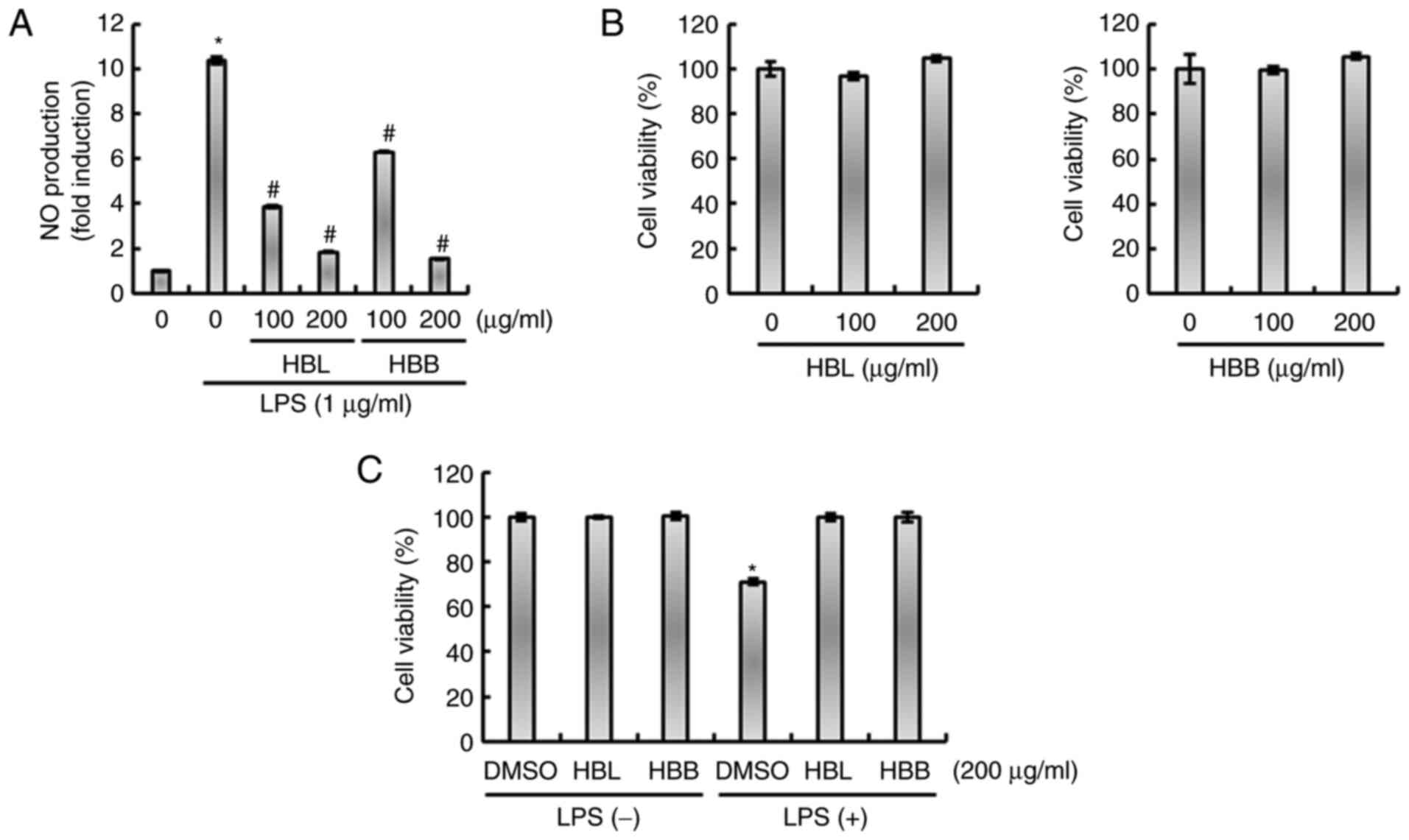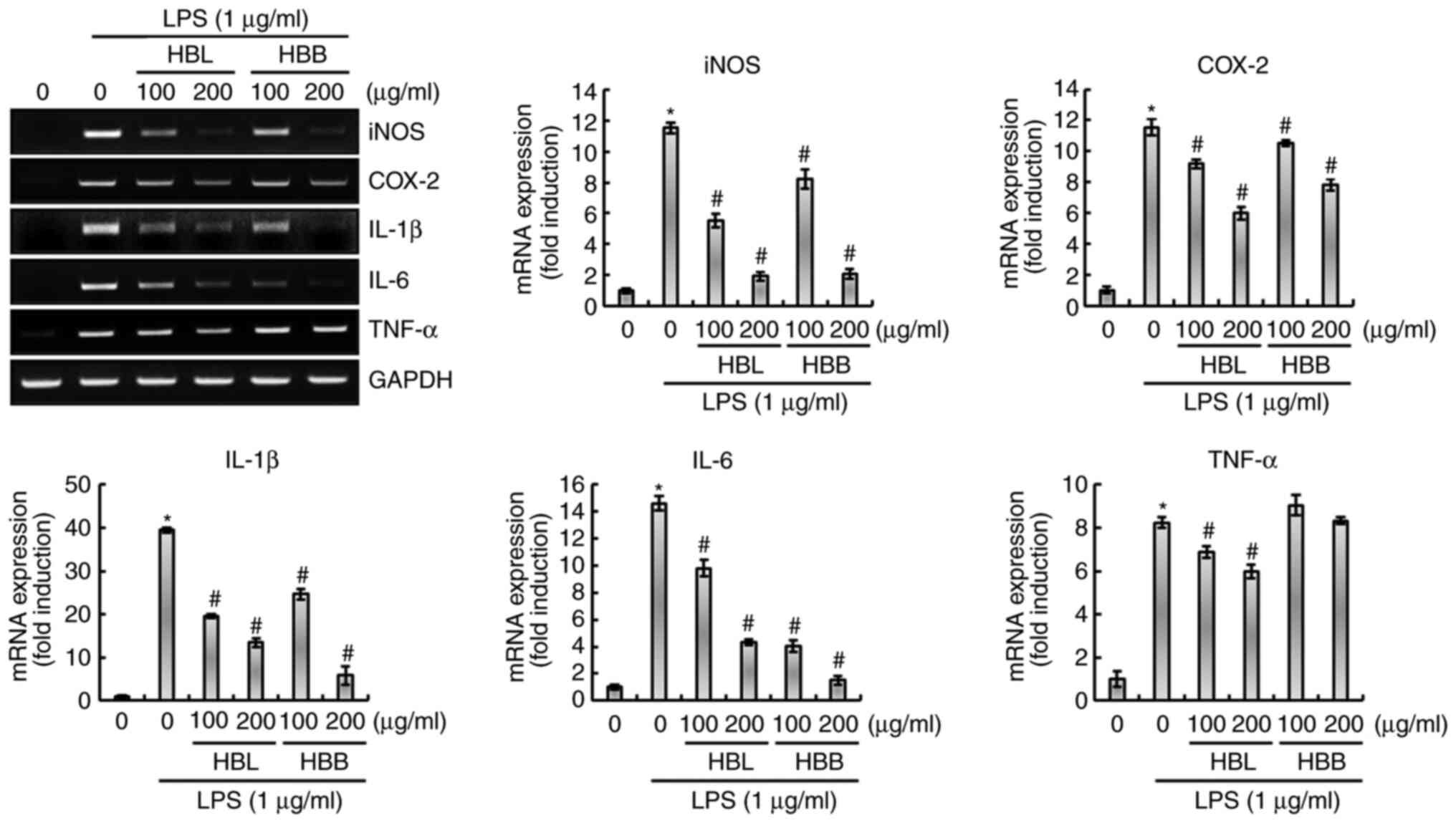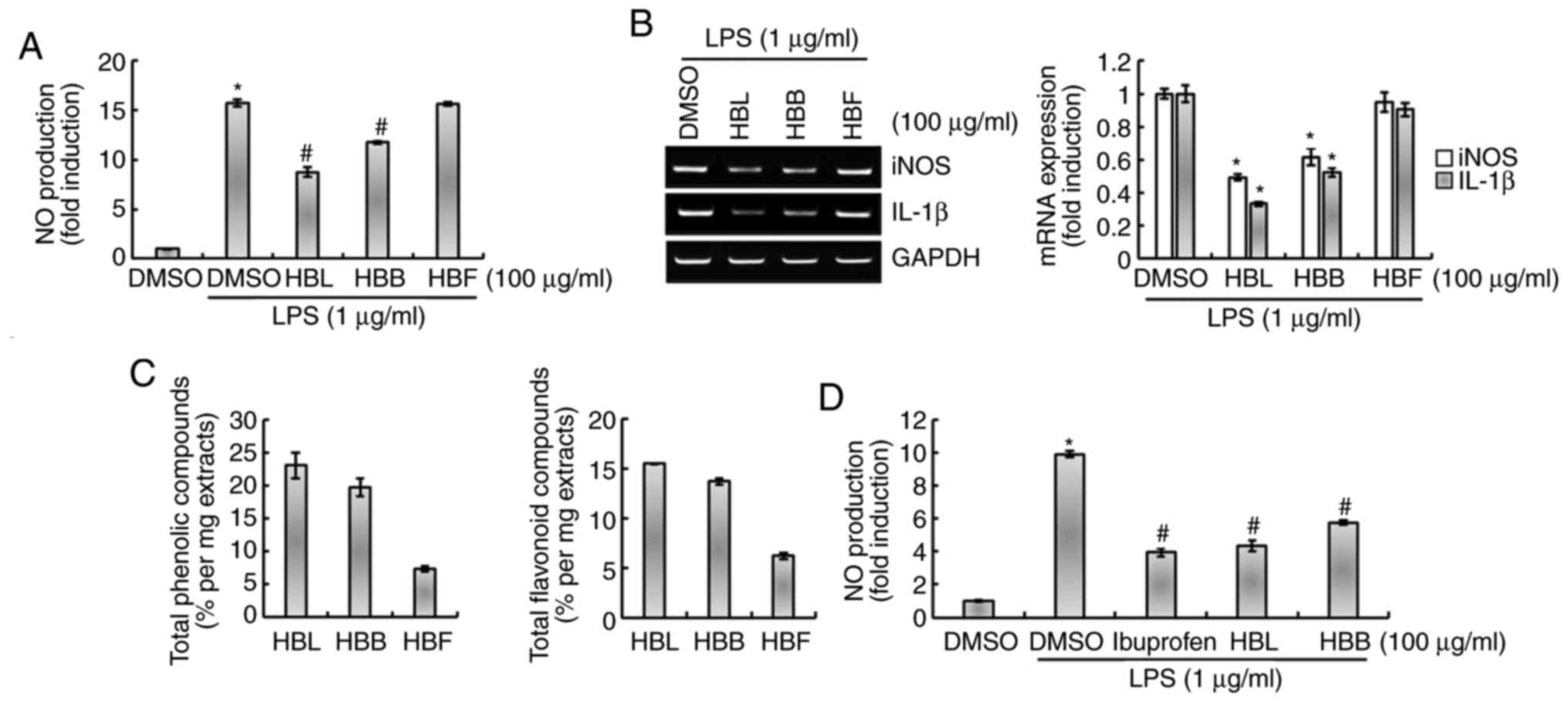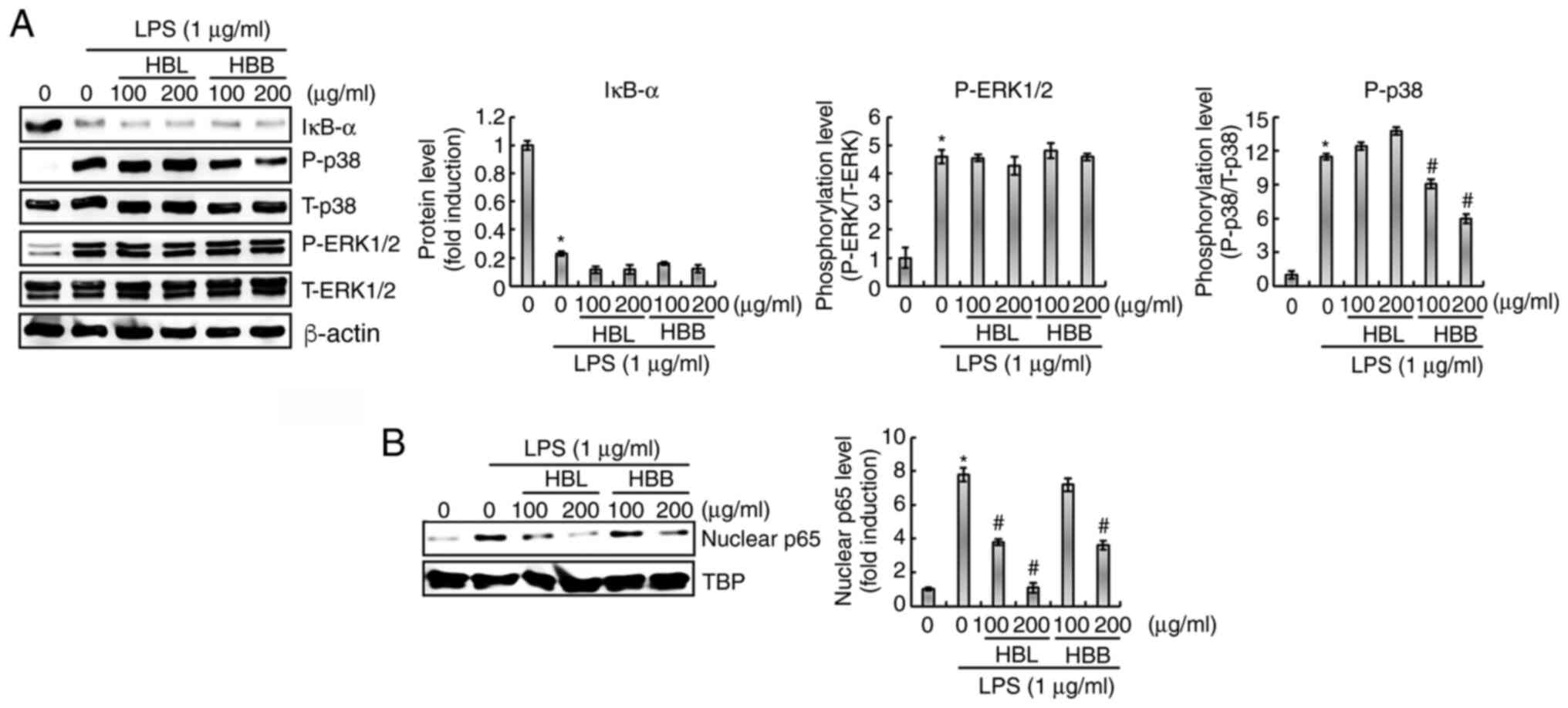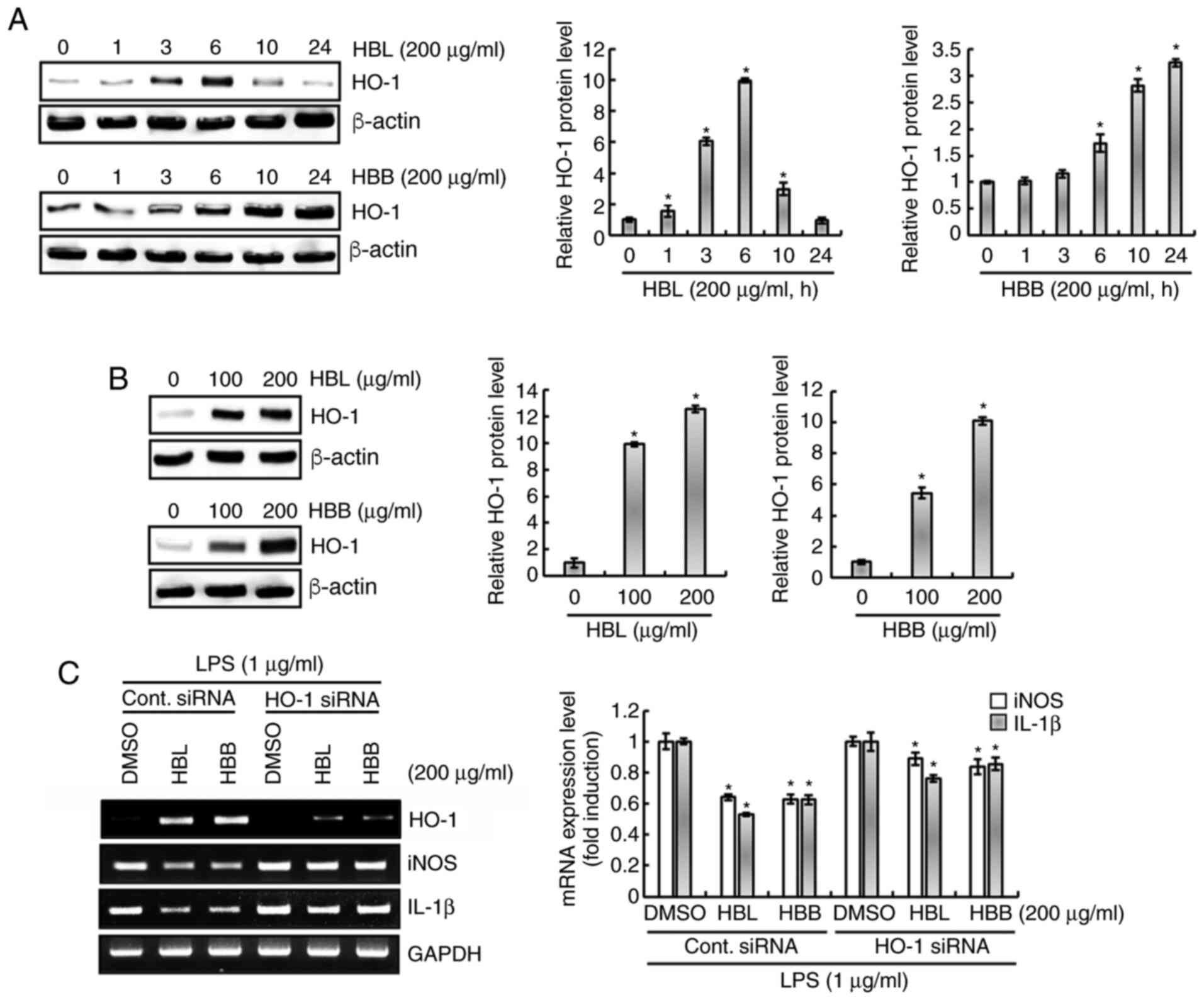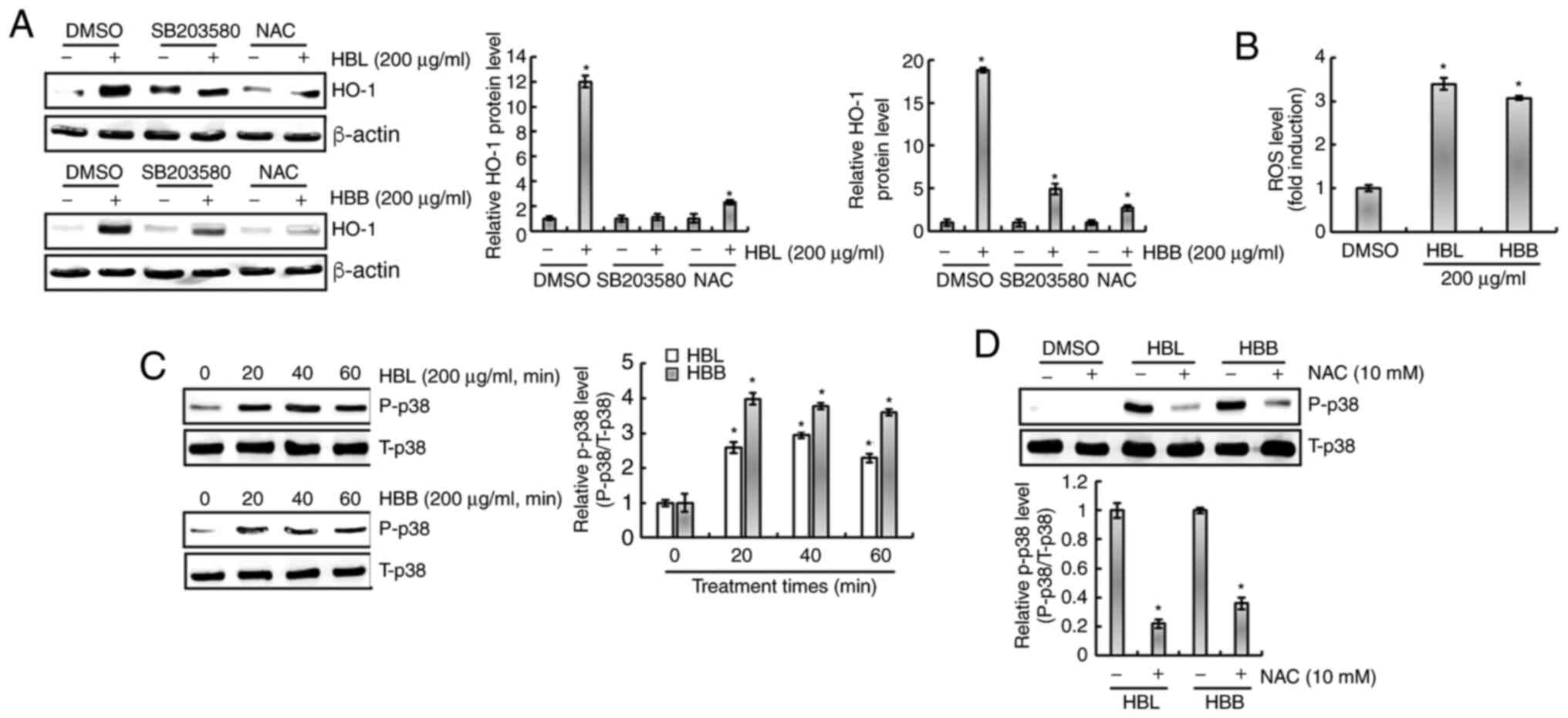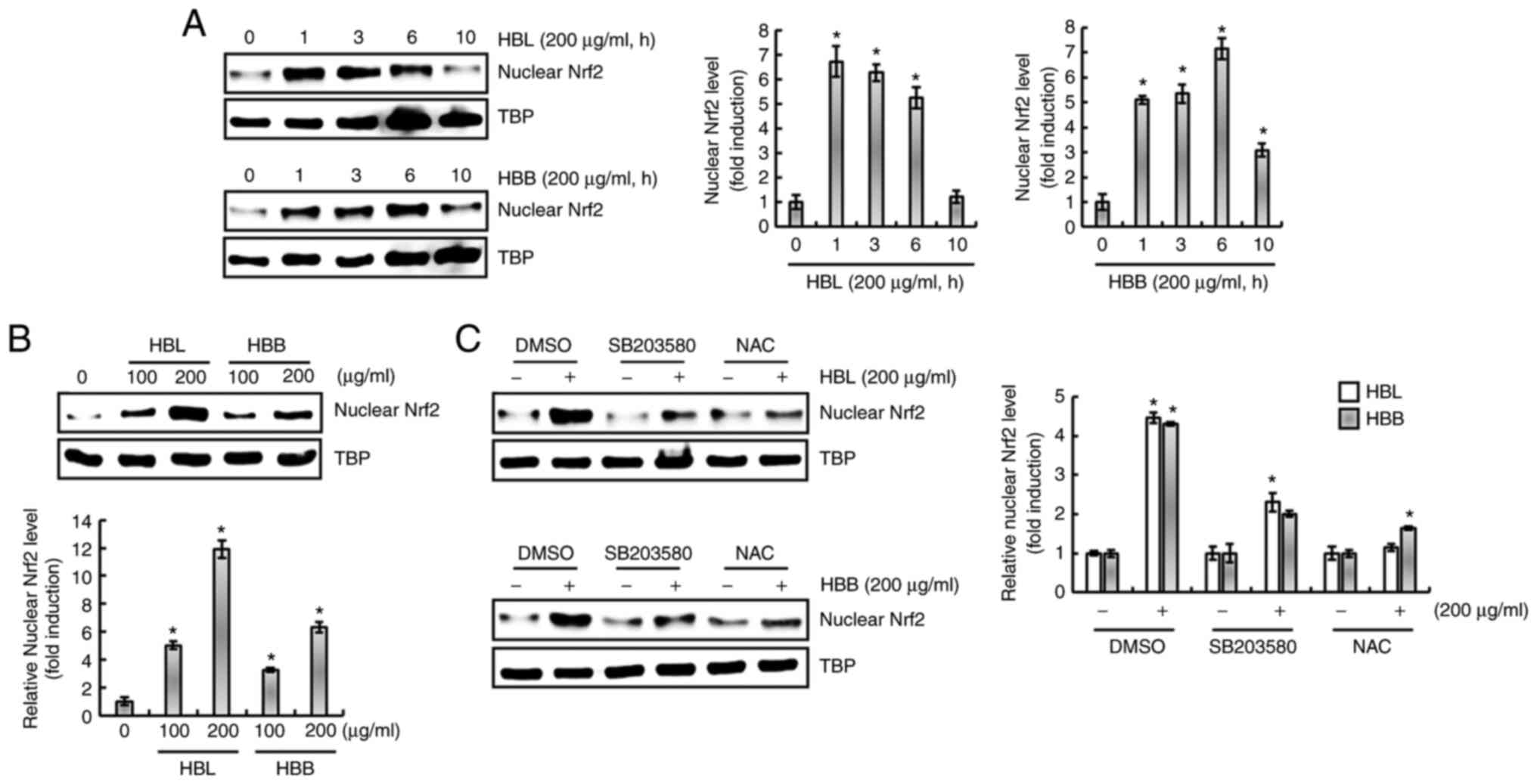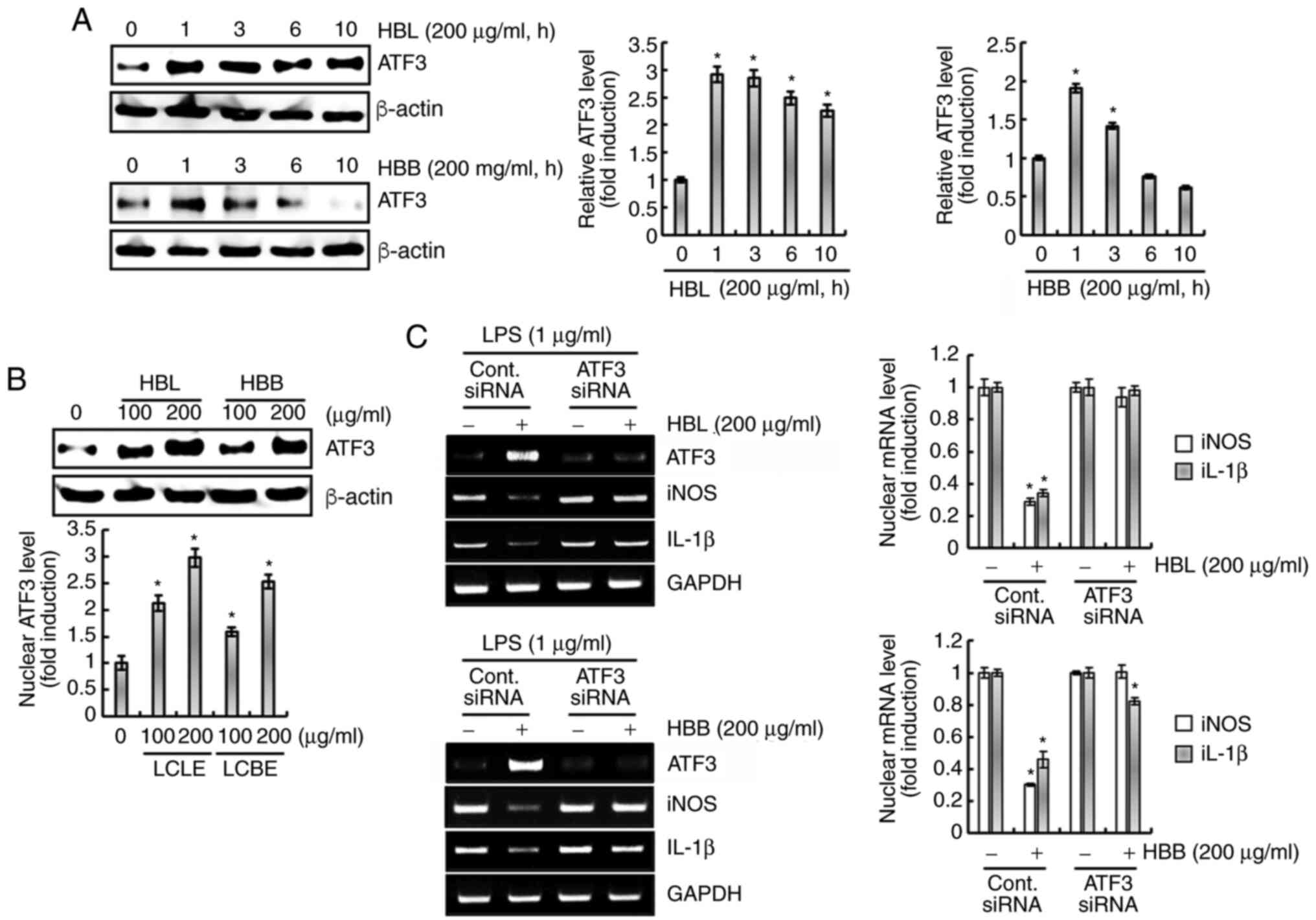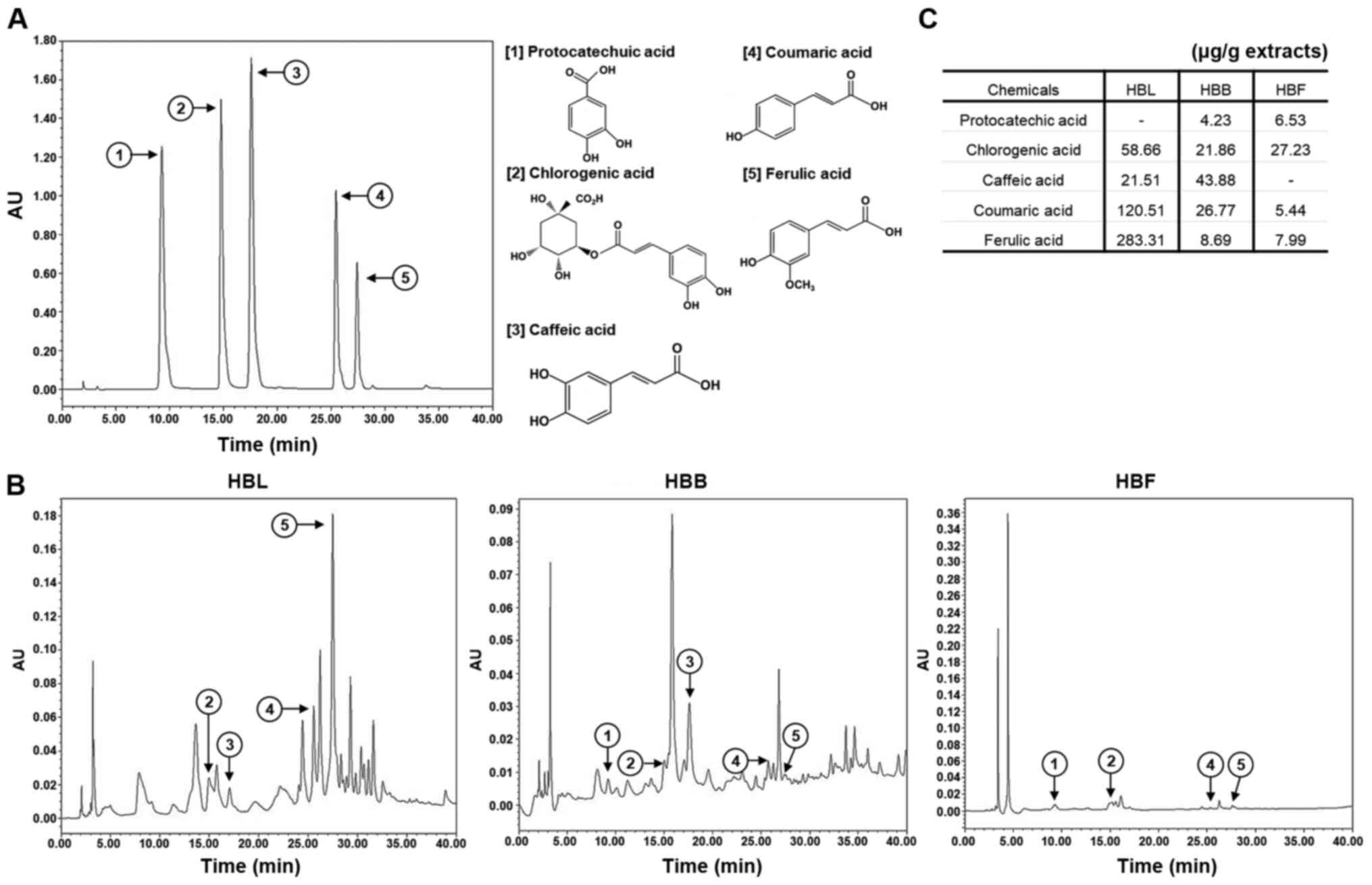|
1
|
Ferrero-Miliani L, Nielsen OH, Andersen PS
and Girardin SE: Chronic inflammation: Importance of NOD2 and NALP3
in interleukin-1beta generation. Clin Exp Immunol. 147:227–235.
2007.PubMed/NCBI
|
|
2
|
Xue N, Wu X, Wu L, Li L and Wang F:
Antinociceptive and anti-inflammatory effect of naringenin in
different nociceptive and inflammatory mice models. Life Sci.
217:148–154. 2019. View Article : Google Scholar : PubMed/NCBI
|
|
3
|
Sieweke MH and Allen JE: Beyond stem
cells: Self-renewal of differentiated macrophages. Science.
342:12429742013. View Article : Google Scholar : PubMed/NCBI
|
|
4
|
Medzhitov R: Inflammation 2010: New
adventures of an old flame. Cell. 140:771–776. 2010. View Article : Google Scholar : PubMed/NCBI
|
|
5
|
Mazzoni L, Perez-Lopez P, Giampieri F,
Alvarez-Suarez JM, Gasparrini M, Forbes-Hernandez TY, Quiles JL,
Mezzetti B and Battino M: The genetic aspects of berries: From
field to health. J Sci Food Agric. 96:365–371. 2016. View Article : Google Scholar : PubMed/NCBI
|
|
6
|
Lee YS, Cho IJ, Kim JW, Lee SK, Ku SK and
Lee HJ: Evaluation of in vitro anti-oxidant and anti-inflammatory
activities of Korean and Chinese Lonicera caerulea. Nutr Res
Pract. 12:486–493. 2018. View Article : Google Scholar : PubMed/NCBI
|
|
7
|
Svarcova I, Heinrich J and Valentova K:
Berry fruits as a source of biologically active compounds: The case
of Lonicera caerulea. Biomed Pap Med Fac Univ Palacky
Olomouc Czech Rupub. 151:163–174. 2017. View Article : Google Scholar
|
|
8
|
Chen L, Xin X, Yuan Q, Su D and Liu W:
Phytochemical properties and antioxidant capacities of various
colored berries. J Sci Food Agric. 94:180–188. 2014. View Article : Google Scholar : PubMed/NCBI
|
|
9
|
Jin XH, Ohgami K, Shiratori K, Suzuki Y,
Koyama Y, Yoshida K, Ilieva I, Tanaka T, Onoe K and Ohno S: Effects
of blue honeysuckle (Lonicera caerulea L.) extract on
lipopolysaccharide-induced inflammation in vitro and in vivo. Exp
Eye Res. 82:860–867. 2006. View Article : Google Scholar : PubMed/NCBI
|
|
10
|
Zdarilova A, Rajnochova Svobodova A,
Chytilova K, Simanek V and Ulrichova J: Polyphenolic fraction of
Lonicera caerulea L. fruits reduces oxidative stress and
inflammatory markers induced by lipopolysaccharide in gingival
fibroblasts. Food Chem Toxicol. 48:1555–1561. 2010. View Article : Google Scholar : PubMed/NCBI
|
|
11
|
Palikova I, Valentova K, Oborna I and
Ulrichova J: Protectivity of blue honeysuckle extract against
oxidative human endothelial cells and rat hepatocyte damage. J
Agric Food Chem. 57:6584–6589. 2009. View Article : Google Scholar : PubMed/NCBI
|
|
12
|
Jurgonski A, Juskiewicz J and Zdunczyk Z:
An anthocyanin-rich extract from Kamchatka honeysuckle increases
enzymatic activity within the gut and ameliorates abnormal lipid
and glucose metabolism in rats. Nutrition. 29:898–902. 2013.
View Article : Google Scholar : PubMed/NCBI
|
|
13
|
Park SI, Lee YJ, Choi SH, Park SJ, Song CH
and Ku SK: Therapeutic effects of blue honeysuckle on lesions of
hyperthyroidism in rats. Am J Chin Med. 44:1441–1456. 2016.
View Article : Google Scholar : PubMed/NCBI
|
|
14
|
Kim JW, Lee YS, Seol DJ, Cho IJ, Ku SK,
Choi JS and Lee HJ: Anti-obesity and fatty liver-preventing
activities of Lonicera caerulea in high-fat diet-fed mice.
Int J Mol Med. 42:3047–3064. 2018.PubMed/NCBI
|
|
15
|
Zhou L, Wang H, Yi J, Yang B, Li M, He D,
Yang W, Zhang Y and Ni H: Anti-tumor properties of anthocyanins
from Lonicera caerulea ‘Beilei’ fruit on human
hepatocellular carcinoma: In vitro and in vivo study. Biomed
Pharmacother. 104:520–529. 2018. View Article : Google Scholar : PubMed/NCBI
|
|
16
|
Pace E, Jiang Y, Clemens A, Crossman T and
Rupasinghe HPV: Impact of thermal degradation of
cyanidin-3-O-glucoside of haskap Berry on cytotoxicity of
hepatocellular carcinoma HepG2 and breast cancer MDA-MB-231 cells.
Antioxidants (Basel). 7:E242018. View Article : Google Scholar : PubMed/NCBI
|
|
17
|
Jurikova T, Rop O, Mlcek J, Sochor J,
Balla S, Szekeres L, Hegedusova A, Hubalek J, Adam V and Kizek R:
Phenolic profile of edible honeysuckle berries (genus Lonicera) and
their biological effects. Molecules. 17:61–79. 2011. View Article : Google Scholar : PubMed/NCBI
|
|
18
|
Vasantha Rupasinghe HP, Arumuggam N,
Amararathna M and De Silva ABKH: The potential health benefits of
haskap (Lonicera caerulea L.): Role of
cyaniding-3-O-glucoside. J Funct Foods. 44:24–39. 2018. View Article : Google Scholar
|
|
19
|
Rupasinghe HP, Boehm MM, Sekhon-Loodu S,
Parmar I, Bors B and Jamieson AR: Anti-inflammatory activity of
haskap cultivars is polyphenols-dependent. Biomolecules.
5:1079–1098. 2015. View Article : Google Scholar : PubMed/NCBI
|
|
20
|
Szopa A, Kokotkiewicz A, Kubica P,
Banaszczak P, Wojtanowska-Krośniak A, Krośniak M, Marzec-Wróblewska
U, Badura A, Zagrodzki P, Bucinski A, et al: Comparative analysis
of different groups of phenolic compounds in fruit and leaf
extracts of Aronia sp.: A. melanocarpa, A. arbutifolia, and
A. ×prunifolia and their antioxidant activities. Eur Food
Res Technol. 243:1645–1657. 2017. View Article : Google Scholar
|
|
21
|
Anchalee R, Ubonrat S, Arpathsra S, Simona
B and Susanna B: Rapid evaluation of phenolic compounds and
antioxidant activity of mulberry leaf tea during storage using
electronic tongue coupled with chemometrics. J Berry Res.
9:563–574. 2019. View Article : Google Scholar
|
|
22
|
Kim HN, Park GH, Park SB, Kim JD, Eo HJ,
Son HJ, Song JH and Jeong JB: Sageretia thea inhibits inflammation
through suppression of NF-κB and MAPK and activation of Nrf2/HO-1
signaling pathways in RAW264.7 cells. Am J Chin Med. 47:385–403.
2019. View Article : Google Scholar : PubMed/NCBI
|
|
23
|
Park YS, Jung ST, Kang SG, Heo BK,
Arancibia-Avila P, Toledo F, Drzewiecki J, Namiesnik J and
Gorinstein S: Antioxidants and proteins in ethylene-treated
kiwifruits. Food Chem. 107:640–648. 2008. View Article : Google Scholar
|
|
24
|
Jin CH, So YK, Han SN and Kim JB:
Isoegomaketone upregulates heme oxygenase-1 in RAW264.7 cells via
ROS/p38 MAPK/Nrf2 pathway. Biomol Ther (Seoul). 24:510–516. 2016.
View Article : Google Scholar : PubMed/NCBI
|
|
25
|
Kwon JW, Kwon HK, Shin HJ, Choi YM, Anwar
MA and Choi S: Activating transcription factor 3 represses
inflammatory responses by binding to the p65 subunit of NF-kB. Sci
Rep. 5:144702015. View Article : Google Scholar : PubMed/NCBI
|
|
26
|
Juman S, Yasui N, Ikeda K, Ueda A,
Sakanaka M, Negishi H and Miki T: Caffeic acid phenethyl ester
suppresses the production of pro-inflammatory cytokines in
hypertrophic adipocytes through lipopolysaccharide-stimulated
macrophages. Biol Pharm Bull. 35:1941–1946. 2012. View Article : Google Scholar : PubMed/NCBI
|
|
27
|
Kim SH, Park SY, Park YL, Myung DS, Rew JS
and Joo YE: Chlorogenic acid suppresses lipopolysaccharide-induced
nitric oxide and interleukin-1β expression by inhibiting JAK2/STAT3
activation in RAW264.7 cells. Mol Med Rep. 16:9224–9232. 2017.
View Article : Google Scholar : PubMed/NCBI
|
|
28
|
Lee M, Rho HS and Choi K:
Anti-inflammatory effects of a p-coumaric acid and kojic acid
derivative in LPS-stimulated RAW264.7 macrophage cells. Biotechnol
Bioproc E. 24:653–657. 2019. View Article : Google Scholar
|
|
29
|
Sakai S, Ochiai H, Nakajima K and Terasawa
K: Inhibitory effect of ferulic acid on macrophage inflammatory
protein-2 production in a murine macrophage cell line, RAW264.7.
Cytokine. 9:242–248. 1997. View Article : Google Scholar : PubMed/NCBI
|
|
30
|
Wang Y, Zhou J, Fu S, Wang C and Zhou B:
Preventive effects of protocatechuic acid on LPS-induced
inflammatory response in human gingival fibroblasts via activating
PPAR-γ. Inflammation. 38:1080–1084. 2015. View Article : Google Scholar : PubMed/NCBI
|
|
31
|
Chen JJ, Deng JS, Huang CC, Li PY, Liang
YC, Chou CY and Huang GJ: p-Coumaric-acid-containing Adenostemma
lavenia ameliorates acute lung injury by activating
AMPK/Nrf2/HO-1 signaling and improving the anti-oxidant response.
Am J Chin Med. 47:1483–1506. 2019. View Article : Google Scholar : PubMed/NCBI
|
|
32
|
Han D, Gu X, Gao J, Wang Z, Liu G, Barkema
HW and Han B: Chlorogenic acid promotes the Nrf2/HO-1
anti-oxidative pathway by activating p21Waf1/Cip1 to
resist dexamethasone-induced apoptosis in osteoblastic cells. Free
Radic Biol Med. 137:1–12. 2019. View Article : Google Scholar : PubMed/NCBI
|
|
33
|
Ma Z, Hong Q, Wang Y, Liang Q, Tan H, Xiao
C, Tang X, Shao S, Zhou S and Gao Y: Ferulic acid induces heme
oxygenase-1 via activation of ERK1/2 and Nrf2. Drug Discov Ther.
5:299–305. 2011. View Article : Google Scholar : PubMed/NCBI
|
|
34
|
Yang SY, Pyo MC, Nam MH and Lee KW:
ERK/Nrf2 pathway activation by caffeic acid in HepG2 cells
alleviates its hepatocellular damage caused by
t-butylhydroperoxide-induced oxidative stress. BMC Complement
Altern Med. 19:1392019. View Article : Google Scholar : PubMed/NCBI
|
|
35
|
Musialik K, Szulińska M, Hen K, Skrypnik D
and Bogdański P: The relation between osteoprotegerin, inflammatory
processes, and atherosclerosis in patients with metabolic syndrome.
Eur Rev Med Pharmacol Sci. 21:4379–4385. 2017.PubMed/NCBI
|
|
36
|
Oguntibeju OO: Medicinal plants with
anti-inflammatory activities from selected countries and regions of
Africa. J Inflamm Res. 11:307–317. 2018. View Article : Google Scholar : PubMed/NCBI
|
|
37
|
Leyva-Jiménez FJ, Lozano-Sánchez J,
Cádiz-Gurrea ML, Arráez-Román D and Segura-Carretero A: Functional
ingredients based on nutritional phenolics. A case study against
inflammation: Lippia genus. Nutrients. 11:16462019. View Article : Google Scholar
|
|
38
|
Yang L, Wen KS, Ruan X, Zhao YX, Wei F and
Wang Q: Response of plant secondary metabolites to environmental
factors. Molecules. 23:7622018. View Article : Google Scholar
|
|
39
|
Chen JW, Chen YH, Lin FY, Chen YL and Lin
SJ: Ginkgo Biloba extract inhibits tumor necrosis
factor-alpha-induced reactive oxygen species generation,
transcription factor activation, and cell adhesion molecule
expression in human aortic endothelial cells. Arterioscler Thromb
Vasc Biol. 23:1559–1566. 2003. View Article : Google Scholar : PubMed/NCBI
|
|
40
|
Maguire O, O'Loughlin K and Minderman H:
Simultaneous assessment of NF-kB/p65 phosphorylation and nuclear
localization using imaging flow cytometry. J Immunol Methods.
423:3–11. 2015. View Article : Google Scholar : PubMed/NCBI
|
|
41
|
Kaminska B: MAPK signalling pathways as
molecular targets for anti-inflammatory therapy-from molecular
mechanisms to therapeutic benefits. Biochim Biophys Acta.
1754:253–262. 2005. View Article : Google Scholar : PubMed/NCBI
|
|
42
|
Frazier WJ, Xue J, Luce WA and Liu Y: MAPK
signaling drives inflammation in LPS-stimulated cardiomyocytes: The
route of crosstalk to G-protein-coupled receptors. PLoS One.
7:e500712012. View Article : Google Scholar : PubMed/NCBI
|
|
43
|
Liu X, Peyton KJ, Shebib AR, Wang H and
Durante W: Compound C stimulates heme oxygenase-1 gene expression
via the Nrf2-ARE pathway to preserve human endothelial cell
survival. Biochem Pharmacol. 82:371–379. 2011. View Article : Google Scholar : PubMed/NCBI
|
|
44
|
Kim J, Cha YN and Surh YJ: A protective
role of nuclear factor-erythroid 2-related factor-2 (Nrf2) in
inflammatory disorders. Mutat Res. 690:12–23. 2010. View Article : Google Scholar : PubMed/NCBI
|
|
45
|
Park SY, Park DJ, Kim YH, Kim Y, Kim SG,
Shon KJ, Choi YW and Lee SJ: Upregulation of heme oxygenase-1 via
PI3K/Akt and Nrf-2 signaling pathways mediates the
anti-inflammatory activity of schisandrin in Porphyromonas
gingivalis LPS-stimulated macrophages. Immunol Lett.
139:93–101. 2011. View Article : Google Scholar : PubMed/NCBI
|
|
46
|
Ren J, Li L, Wang Y, Zhai J, Chen G and Hu
K: Gambogic acid induces heme oxygenase-1 through Nrf2 signaling
pathway and inhibits NF-kB and MAPK activation to reduce
inflammation in LPS-activated RAW264.7 cells. Biomed Pharmacother.
109:555–562. 2019. View Article : Google Scholar : PubMed/NCBI
|
|
47
|
Lim DW, Choi HJ, Park SD, Kim H, Yu GR,
Kim JE and Park WH: Activation of the Nrf2/HO-1 pathway by
Amomum villosum extract suppresses LPS-induced oxidative
stress in vitro and ex vivo. Evid Based Complement Alternat Med.
2020:28378532020. View Article : Google Scholar : PubMed/NCBI
|
|
48
|
Habtemariam S: The Nrf2/HO-1 axis as
targets for flavanones: Neuroprotection by pinocembrin, naringenin,
and eriodictyol. Oxid Med Cell Longev. 2019:47249202019. View Article : Google Scholar : PubMed/NCBI
|
|
49
|
Thompson MR, Xu D and Williams BR: ATF3
transcription factor and its emerging roles in immunity and cancer.
J Mol Med (Berl). 87:1053–1060. 2009. View Article : Google Scholar : PubMed/NCBI
|
|
50
|
Hai T, Wolford CC and Chang YS: ATF3, a
hub of the cellular adaptive-response network, in the pathogenesis
of diseases: Is modulation of inflammation a unifying component.
Gene Expr. 15:1–11. 2010. View Article : Google Scholar : PubMed/NCBI
|
|
51
|
Takii R, Inouye S, Fujimoto M, Nakamura T,
Shinkawa T, Prakasam R, Tan K, Hayashida N, Ichikawa H, Hai T and
Nakai A: Heat shock transcription factor 1 inhibits expression of
IL-6 through activating transcription factor 3. J Immunol.
184:1041–1048. 2010. View Article : Google Scholar : PubMed/NCBI
|
|
52
|
Rao J, Qian X, Li G, Pan X, Zhang C, Zhang
F, Zhai Y, Wang X and Lu L: ATF3-mediated NRF2/HO-1 signaling
regulates TLR4 innate immune responses in mouse liver
ischemia/reperfusion injury. Am J Transplant. 15:76–87. 2015.
View Article : Google Scholar : PubMed/NCBI
|















